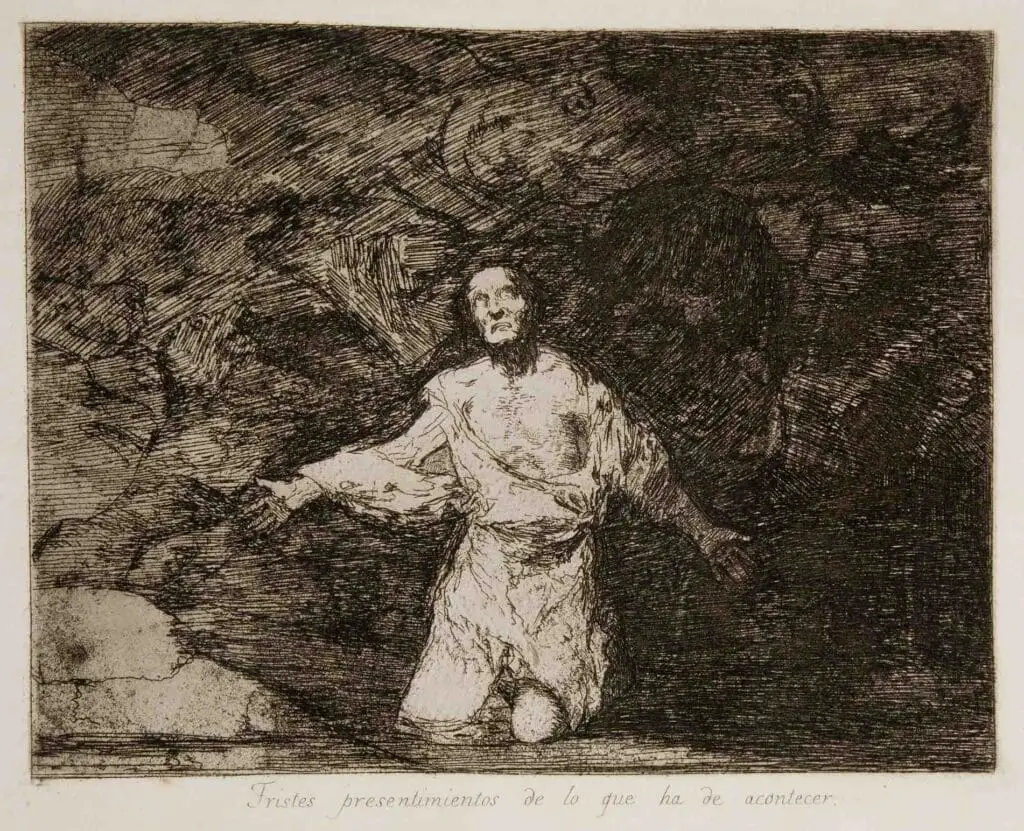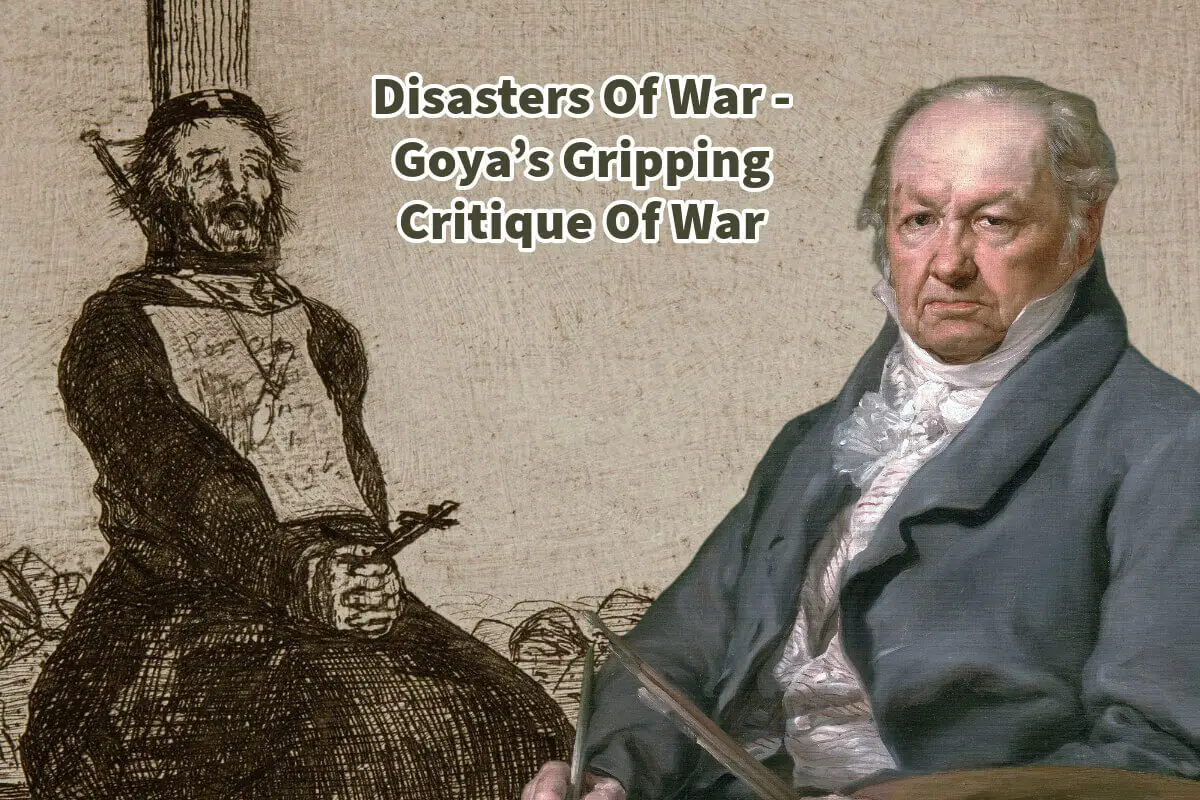Francisco Goya is one of the most significant Spanish artists ever. He is renowned for many works, notably his series titled “Disasters of War.”
In “Disasters of War,” Goya takes the viewer on an artistic journey through a series of etchings, conveying the profound impact of conflict. Through intricate etchings, Goya uncovers the stark terrors of warfare, exploring timeless narratives of human anguish, societal breakdown, and the lasting scars of conflict.
Table of Contents
- The Depth Of Despair: Goya’s Gripping Critique Of War – Despairs
- Reverberations In Modern Culture: With Disasters Of War
- Francisco Goya’s “The Disasters Of War”: A Grisly Chronicle Of Conflict And Consequence
- The Craft Behind Goya’s “Disasters of War”: An Exploration Into His Etching Process
- Frequently Asked Questions
- Related Questions
The Depth Of Despair: Goya’s Gripping Critique Of War – Despairs
Goya’s “The Disasters of War” is a raw, candid look into the aftermath of conflict, a savage critique of the senselessness of war and the suffering it inflicts upon innocent civilians. Through detailed etchings, Goya reveals the visceral horrors of conflict, delving into the universal themes of human suffering, societal collapse, and the enduring consequences of war.

The Grisly Reality Over Romanticism
Unlike many of his contemporaries, Goya shunned the romantic, often glamorized depictions of warfare. Instead, he was ruthlessly realistic. His images depict not grand, hero-filled battles but the dark aftermath: mutilated corpses, starving citizens, torture, and rape. It’s an unrelenting parade of humanity at its worst.
In one particularly harrowing etching, a man is seen impaled on a tree, his lifeless body serving as a grotesque testament to the cruelty of war. In another, a group of skeletal, emaciated figures huddle together, representing the starving populace.
The Political Undertones Of His Disasters Of War
Beyond the immediate horrors of the war, Goya also touched on the broader implications of the conflict. His work hints at his disapproval of the Spanish Inquisition and the oppressive regime that emerged post-war.
His etchings reflect a society grappling with chaos, where ideologies clash, and the common folk bear the brunt of the elites’ power struggles.

Reverberations In Modern Culture: With Disasters Of War
Goya’s influence on later artists and thinkers is undeniable. Pablo Picasso’s “Guernica,” a visceral response to the bombing of the Basque town during the Spanish Civil War, can trace its roots back to “The Disasters of War.” Picasso, like Goya, sought to capture the raw, unfiltered emotions of a society under siege.
Ernest Hemingway’s “For Whom the Bell Tolls” explores the human cost of war, themes that echo Goya’s powerful etchings. Hemingway’s portrayal of the Spanish Civil War’s brutality and its effects on individuals is a literary parallel to Goya’s visual masterpieces.
The Contemporary Relevance Of Disasters Of War
Its universal message makes “The Disasters of War” so enduring. Even as warfare has evolved, the pain, suffering, and societal consequences it depicted remain relevant. In our era of drone strikes, civil unrest, and refugee crises,
Goya’s haunting images serve as a grim reminder of the human cost of conflict.
Moreover, in a world where images of war are sanitized or censored, Goya’s commitment to showing unvarnished truths is commendable. His refusal to stop depicting the grim realities is a benchmark for artists and journalists today.
Francisco Goya’s “The Disasters of War” is one of art history’s most powerful anti-war statements. While it is rooted in a specific time and place, its themes are timeless.
As long as warfare and conflict persist, Goya’s etchings will remain a necessary testament to the ensuing horrors, urging humanity to remember, reflect, and, hopefully, choose a different path.
Francisco Goya’s “The Disasters Of War”: A Grisly Chronicle Of Conflict And Consequence
In the vast panorama of art that has depicted war, Francisco Goya’s “The Disasters of War” stands apart, not just for its unflinching look at the horrors of conflict but also for its astute chronicling of the cascading tragedies war brings in its wake.

Through a series of meticulously crafted etchings, Goya takes the viewer on a harrowing journey that moves beyond the immediate chaos of battlefields to delve into war’s more profound societal and political ramifications.
Narrative Over Aesthetics
Goya’s shift from traditional compositions, which often sought to ennoble or romanticize war, to a narrative-centric approach underscored the brutal reality of the Peninsular War. He was less concerned with crafting ‘beautiful’ images and more invested in using his art as a documentary tool.
The rawness of each plate, with its meticulous detailing, feels almost journalistic in its intent.
The Horrors Of War
The initial plates, centered on the conflict, are haunting. In them, the Spanish countryside is transformed into a nightmarish landscape where innocence is perpetually violated. Goya does not shield the viewer. Instead, he compels us to witness acts of brutality with stark clarity.
The title “I Saw It” goes beyond mere observation; it serves as an indictment, a firsthand testimony of the atrocities that transpired. Goya seems to be challenging the viewer in these etchings, forcing them to confront the visceral reality of war, stripped of any romantic veneer.
Famine And Desolation
The war’s aftermath, which Goya delves into in plates 48 to 64, is no less harrowing. Here, we are confronted with the skeletal remnants of a population ravaged by hunger. The streets of Madrid, once echoed with life, now reverberate with the hushed whispers of death.
The skeletal figures, their eyes vacant, carry an aura of resigned desolation. In this section, war is not just about battles and soldiers but about the silent, creeping death that engulfs cities and communities in its wake.
The Bitter Irony Of Post-War Politics
In the concluding plates, Goya’s focus shifts to the more enormous societal implications of the war. Here, his critique is sharp and unyielding. Having borne the brunt of the conflict and the famine, the Spanish find themselves under a monarchy that is indifferent to their plight.
Goya’s etchings in this section are replete with dark irony. His skepticism towards the religious and political establishment is evident, as he portrays a society grappling with disillusionment and a sense of betrayal.
Moreover, as we move through the series, the lines blur between the oppressors and the oppressed. This deliberate ambiguity is a potent commentary on the cyclical nature of violence, where today’s victims can quickly become tomorrow’s oppressors.
“The Disasters of War” is more than just a series of etchings. It’s a searing chronicle of the human condition during times of extreme crisis. With each plate, Goya captures a moment in time and offers a timeless reflection on the cost of war.
In his unrelenting portrayal of suffering, he makes an impassioned plea for empathy, understanding, and peace. In today’s tumultuous times, Goya’s work is a sad reminder of the horrors we can inflict upon each other and the need for relentless introspection.

The Craft Behind Goya’s “Disasters of War”: An Exploration Into His Etching Process
Francisco Goya’s “Disasters of War” is a heartrending visual commentary on the brutalities of conflict. But beyond its emotive charge, the series is a testament to Goya’s mastery of printmaking techniques. By marrying etching, drypoint, and aquatint, Goya employed a technical trifecta that lent depth, texture, and tonal richness to each piece.
Embracing The Shadows: The Power Of Monochrome
Goya’s deliberate choice to shun color and instead delve into a world of shadows and contrasts was no accident. His reliance on grayscale wasn’t just a stylistic choice but a thematic one.
The darkness and the interplay of light and shadow conveyed the grimness of war far more effectively than color ever could. Through a meticulous process, Goya transformed his copper plates into bleak landscapes of suffering.
Etching: The Beginning Of The Process
The etching forms the foundation of Goya’s printmaking. He first coated a copper plate with a thin layer of wax. Delicate, intricate lines were sketched onto this waxy surface with a sharp needle.
When the plate was submerged in an acid bath, the acid gnawed away at the exposed copper. Once sufficiently etched, the plate was cleaned, and the protective wax was removed, revealing a network of grooves that would hold the ink.
Drypoint: Texturing The Narrative
Beyond basic etching, Goya incorporated the drypoint technique. Instead of working with wax, Goya directly scratched the copper plate. This method produces lines with characteristic softness, and the resulting burr, or the raised edge of copper, captures more ink.
This gives the print a more decadent, textured feel, adding a tangible dimension to the poignant scenes.
Aquatint: Mastery Of Tone
For Goya, capturing the perfect shade was paramount. The aquatint process allowed him to achieve this. A powdered resin was sprinkled onto the plate, which was then heated, causing the resin to melt and harden.
When acid was applied, it bit into the spaces between the hardened resin particles, creating channels. The depth of these channels, determined by the duration of acid exposure, would dictate the tonality of the ink, ranging from the faintest grays to the deepest blacks.
Final Impression: Transferring Emotion Onto Paper
The final step was both delicate and dramatic. The etched plate was inked, and the surplus was wiped away, leaving ink only within the grooves. When pressed onto dampened paper with considerable force using a printing press, the ink transferred, imprinting a reversed image of the plate.
Legacy Beyond The Craft
Through the intricate dance of etching, drypoint, and aquatint, Goya gave the world a sobering insight into the horrors of war. More than a showcase of his technical prowess, “Disasters of War” is a compelling demonstration of how art can transcend its medium to become a poignant social commentary.
As we admire the details, the shades, and the textures, we’re also reminded of Goya’s genius—not just as an artist but as a chronicler of the human condition.
Anita Louise Art is dedicated to art education, great artists, and inspiring others to find and create their art. We love art that uplifts and inspires. #ArtToMakeYouSmile! #ArtToMakeYouHappy!
If you want to see any of my art, you can find out more by clicking here. If you are interested in what inspires me and my paintings, you can discover more by clicking here.
We have a free newsletter and would love you to be part of our community; you can subscribe to the newsletter by clicking here. I would be happy to talk to you if you have any questions. You can reach me, Anita, by clicking here.
Subscribe to our Anita Louise Art YouTube Channel with great videos and information by clicking here.
Join us for our podcast “5 Minutes With Art.” Spend just 5 minutes a week with us to discover and learn about great art and artists. You can find out more about our podcast by clicking here.
Frequently Asked Questions
What is “Disasters of War,” and why is it considered a significant work by Francisco Goya?
“Disasters of War” is a series of 82 etchings created by Francisco Goya. It is considered significant for its powerful depiction of the harsh realities and horrors of war, providing a stark critique of the brutality and human suffering associated with armed conflict.
When did Goya create the “Disasters of War” series, and what inspired him to undertake such a project?
Goya created the series between 1810 and 1820, during the Peninsular War and the subsequent political turmoil in Spain. The inspiration came from the artist’s own experiences and observations of the devastating consequences of war on both soldiers and civilians.
How did Goya convey the impact of war through the medium of etching in “Disasters of War”?
Goya used the medium of etching to create detailed and evocative scenes, capturing the raw emotions and chaos of war. The use of this technique allowed him to produce powerful and haunting images that communicated the horrors of conflict.
What are some common themes explored in “Disasters of War”?
The series delves into various themes, including the brutality of soldiers, the suffering of civilians, the breakdown of societal norms, and the psychological toll of war. Goya’s work transcends time, making these themes universally relevant.
How did “Disasters of War” challenge traditional notions of glorifying war in art?
Goya’s series went against the prevailing trend of glorifying war in art during his time. Instead, he presented a raw and unflinching portrayal of the grim realities, challenging the romanticized depictions of conflict prevalent in contemporary art.
What role did Goya’s own experiences play in shaping the narrative of “Disasters of War”?
Goya witnessed the atrocities and hardships of war firsthand, and these experiences heavily influenced the content of “Disasters of War.” His personal encounters with the consequences of conflict infused the series with authenticity and emotional depth.
How was “Disasters of War” received during Goya’s lifetime?
Goya did not intend for the series to be widely circulated during his lifetime due to its provocative nature. It was only published posthumously, and its impact grew significantly in later years as people recognized its artistic and social significance.
In what ways does “Disasters of War” remain relevant in the contemporary context?
Despite being created in the early 19th century, the themes depicted in “Disasters of War” continue to resonate in modern times. The series serves as a timeless commentary on the enduring human cost and societal consequences of war.
Related Questions
Grandma Moses Sold Her First Painting At Age 79 – And Other Facts
Grandma Moses started painting at age 78 and sold her first paintings at 79. She lived to be 101 years old, and throughout that time, she was a prolific painter that painted over 1500 different paintings. She never had the opportunity to attend art school, so she was a completely self-taught painter.
By clicking here, you can learn more by reading Grandma Moses Sold Her First Painting At Age 79 – And Other Facts.
Art And History – Understanding Our Past
When we study art, it helps us understand and gives us clues about the past. As we see what the artist has painted, we can piece together what life was like during that time in history. Art also helps us better understand the cultures and people who once lived their life.
You can discover more by reading Art and History – Understanding Our Past by clicking here.
Am I Too Old To Start Oil Painting?
You are never too old to learn to oil paint. You can start to oil paint at any age. If Grandma Moses could learn to paint at age 78, she set an example for us all – that you are never too old to learn to paint. There are some advantages to learning to paint when you are older vs. younger.
By clicking here, you can discover more by reading Am I Too Old To Start Oil Painting?

